| |
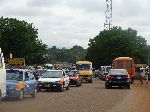 Though I neglected to get a picture of the traffic in the center of Accra, I did
take a picture of the bumper-to-bumper traffic on the outskirts of town -- it
was about the same. Accra region traffic jams can stretch for many
kilometers.
Though I neglected to get a picture of the traffic in the center of Accra, I did
take a picture of the bumper-to-bumper traffic on the outskirts of town -- it
was about the same. Accra region traffic jams can stretch for many
kilometers.
The University of Ghana at Legon (formerly the University College of the Gold
Coast, and Legon University) is on a spacious wooded campus, 12 km north of
Accra. It was founded in 1948. The
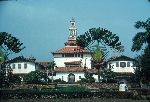 architecture elements of the buildings draws from a number of traditions,
including red tile roofs (Mediteranean), flared eves (Asian), columns (Classic), clock towers, square and round
windows, and stucco exteriors (Mission). Collectively they fit together nicely and
have a lightness to them. The campus seems very relaxed. Legon has
cooperative agreements with a number of overseas universities so it is not
unusual to see European and American students moving about on the
campus.
architecture elements of the buildings draws from a number of traditions,
including red tile roofs (Mediteranean), flared eves (Asian), columns (Classic), clock towers, square and round
windows, and stucco exteriors (Mission). Collectively they fit together nicely and
have a lightness to them. The campus seems very relaxed. Legon has
cooperative agreements with a number of overseas universities so it is not
unusual to see European and American students moving about on the
campus.
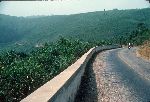
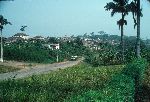 A
few kilometers north of Legon are the foothills of the Akwapim Ridge or Plateau.
Actually the foothills are pretty miniscule and the change is topography is
pretty precipitous, raising about 350 meters. Once on top the road is
relatively flat, though at times it rolls
along with the ridge line,
which can create short steep hills. A
few kilometers north of Legon are the foothills of the Akwapim Ridge or Plateau.
Actually the foothills are pretty miniscule and the change is topography is
pretty precipitous, raising about 350 meters. Once on top the road is
relatively flat, though at times it rolls
along with the ridge line,
which can create short steep hills.
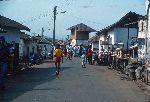 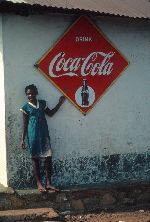 A favorite weekend training ride for
road cyclists in Accra is a morning circuit up the hill to Aburi and return (~60 kilometers
roundtrip). If you are in quite so much of a hurry it is nice to go
further and stop and visit with the drum makers and craftsmen for which the area
is known. A favorite weekend training ride for
road cyclists in Accra is a morning circuit up the hill to Aburi and return (~60 kilometers
roundtrip). If you are in quite so much of a hurry it is nice to go
further and stop and visit with the drum makers and craftsmen for which the area
is known.
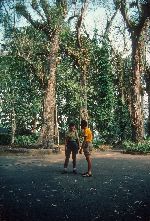 As you move away from the coast the humidity drops a little
and as you rise in elevation the temperature drops a little. This, in
combination, with a picturesque setting makes Aburi desirable destination.
An addition feature of Aburi is its botanical garden. It officially opened
in March, 1895. The royal palms that line the As you move away from the coast the humidity drops a little
and as you rise in elevation the temperature drops a little. This, in
combination, with a picturesque setting makes Aburi desirable destination.
An addition feature of Aburi is its botanical garden. It officially opened
in March, 1895. The royal palms that line the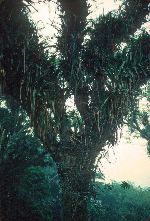 entrance road are
more than 100 years old. Within the collection are enormous kapok trees, a
variety of palms, thousands of epiphytes and hundreds of plants from the
tropical world. Most of the species are exotics so it is not a entrance road are
more than 100 years old. Within the collection are enormous kapok trees, a
variety of palms, thousands of epiphytes and hundreds of plants from the
tropical world. Most of the species are exotics so it is not a
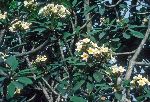 good place to
learn about indigenous botany. The
garden has had numerous ups and downs over the century. It is hard to
predict how good a shape it will be in from year-to-year. Some years it is
pretty scruffy and pocked with liter and on other visits it can be in near
pristine condition. good place to
learn about indigenous botany. The
garden has had numerous ups and downs over the century. It is hard to
predict how good a shape it will be in from year-to-year. Some years it is
pretty scruffy and pocked with liter and on other visits it can be in near
pristine condition.
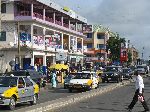
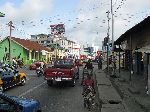
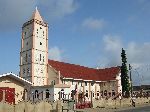 Northwest of the Akwapim ridge is Koforidua. It is generally a very likable
medium size town, but what really stands out and is impressive is the Ability
Northwest of the Akwapim ridge is Koforidua. It is generally a very likable
medium size town, but what really stands out and is impressive is the Ability
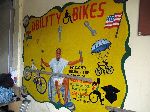 Bikes
Cooperative. If you need a bike repaired in the Eastern Region of Ghana it is
the go to place. I have rarely been in a bike shop anywhere were the
employees were so focused on their work and the task at hand. If you asked
to take a picture the crew would look up briefly and smile and then quickly put
their heads back down and continue to work. The staffs diligence and competency
is what is most striking, but with a closer look, masked in the efficiency, all
the members of the staff have some physical challenged. Bikes
Cooperative. If you need a bike repaired in the Eastern Region of Ghana it is
the go to place. I have rarely been in a bike shop anywhere were the
employees were so focused on their work and the task at hand. If you asked
to take a picture the crew would look up briefly and smile and then quickly put
their heads back down and continue to work. The staffs diligence and competency
is what is most striking, but with a closer look, masked in the efficiency, all
the members of the staff have some physical challenged.
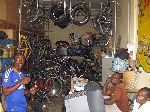
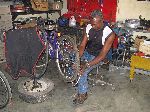
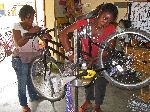
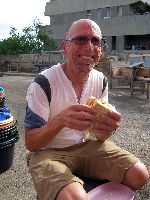 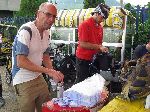 A
brief note here about food and water: The preferred breakfast was an
omelet sandwich. There were other items available in the morning like
porridge, and rice and bean dishes, but when they were available this group went for the
eggs and bread. The most convenient source of sterile was is half-liter sachets.
The group was big enough and had enough carrying capacity that they often bought
a large bag containing 30 sachets (15 liters of water). Each sachet cost the
equivalent of a few U.S. cents. This all had the draw back of leaving a
heap of plastic trash. A
brief note here about food and water: The preferred breakfast was an
omelet sandwich. There were other items available in the morning like
porridge, and rice and bean dishes, but when they were available this group went for the
eggs and bread. The most convenient source of sterile was is half-liter sachets.
The group was big enough and had enough carrying capacity that they often bought
a large bag containing 30 sachets (15 liters of water). Each sachet cost the
equivalent of a few U.S. cents. This all had the draw back of leaving a
heap of plastic trash.
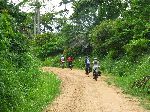
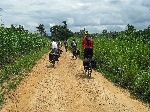
The back roads of Eastern Region pass through a mosaic of forest and farmland.
The population is relatively sparse so there is still a considerable amount of
forest along the roads. One of the major crops in the area is cocoa, which
likes to grow in the shade, so as a bi-product of this industry the forest
canopy is preserved -- two thumbs up.
The first cocoa plants in Ghana were planted in Akwapim in 1887.
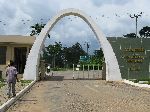
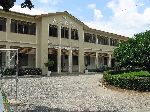 It is fitting that our next major stop was the Cocoa Research Institute of Ghana (CRIG) The
institute was started in 1939 as the West Africa Cocoa Research Institute, but
since de-colonization has become a Ghanaian operation.
It is fitting that our next major stop was the Cocoa Research Institute of Ghana (CRIG) The
institute was started in 1939 as the West Africa Cocoa Research Institute, but
since de-colonization has become a Ghanaian operation.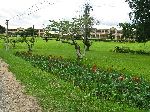
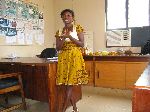 If
you are interested in all things cocoa this is the place to go. At CRIG,
the guy were very attentive and took an unusually deep interest in our tour on
identifying varieties, preparing and processing the cocoa, but I am sort thinking that it might have
something to do with the engagingness of our tour guide. If
you are interested in all things cocoa this is the place to go. At CRIG,
the guy were very attentive and took an unusually deep interest in our tour on
identifying varieties, preparing and processing the cocoa, but I am sort thinking that it might have
something to do with the engagingness of our tour guide.
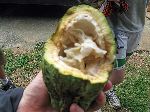
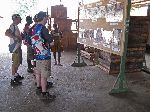
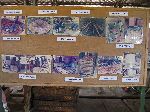
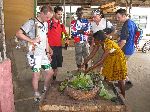
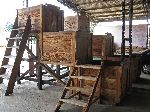
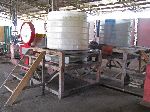
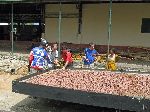
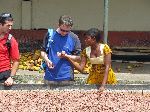
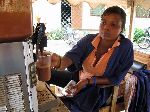
In case you want to know, to make chocolate you start with a cocoa pod.
Out of this comes the "nib". The nib must be roasted or fermented and
dried. We were told that one of the secrets to good cocoa is in the
fermentation -- on which Ghanaian producers excell. There are five methods of fermentation; heap fermentation,
basket fermentation, box fermentation, and tray fermentation. Finally the
prepared nib is ground and refined into a paste or "liquor." It is from
the liquor that chocolate and other products (i.e. cocoa butter, cocoa soap,
etc.) are manufactured. CRIG is doing research on other uses for cocoa. In
the garden outside of the headquarters they sell a cool refreshing cocoa drink.
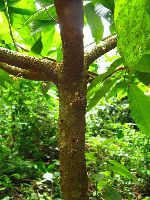
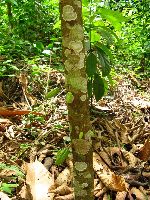
These two pictures show very young cocoa pods. The picture to the left shows a
few pea-size white pods. The picture on the right show there more mature
color and shape, but when they are fully mature they will be several times
bigger and when the are ready to pick they will have more of an amber color.
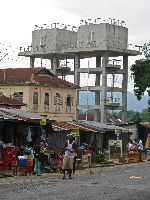 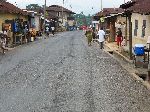 Continuing
our tour we passed through Osiem, a typical small town with a cross-roads, shops
lining the main street, market area, new water tower (running water),
electricity, Continuing
our tour we passed through Osiem, a typical small town with a cross-roads, shops
lining the main street, market area, new water tower (running water),
electricity,
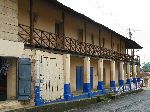 and
a couple of buildings that are architecturally a cut above. Compared to
Accra, and even Koforidua, the pace of life in these towns is relaxed. It
is typical that the young Ghanaians who live in these towns are trying to escape
to the bigger cities, but if you are looking to land in a place with a modicum
of creature comforts and where you can hear yourself think these small towns
have a lot of appeal. and
a couple of buildings that are architecturally a cut above. Compared to
Accra, and even Koforidua, the pace of life in these towns is relaxed. It
is typical that the young Ghanaians who live in these towns are trying to escape
to the bigger cities, but if you are looking to land in a place with a modicum
of creature comforts and where you can hear yourself think these small towns
have a lot of appeal.
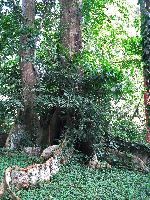 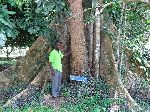 Just
down the road is the Bunso Arboretum. In contrast to Aburi Botanical
Garden, a larger proportion of the collection at Bunso Arboretum is indigenous. Just
down the road is the Bunso Arboretum. In contrast to Aburi Botanical
Garden, a larger proportion of the collection at Bunso Arboretum is indigenous.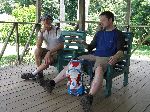 As part of the collection there is a butterfly garden, and a herb garden (with
medicinal and aromatic plants). The Arboretum is home to over 110 species of
birds, some of which are very rare. Bunso was established in 1905, so it
is slightly newer than Aburi.
As part of the collection there is a butterfly garden, and a herb garden (with
medicinal and aromatic plants). The Arboretum is home to over 110 species of
birds, some of which are very rare. Bunso was established in 1905, so it
is slightly newer than Aburi.
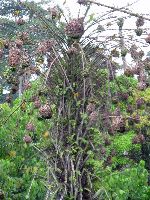 The
Collins Field Guide to the Birds of West Africa lists more than fifteen
varieties of weaver birds. They are all about the same size, often
gregarious, often noisy and about half of them are predominantly yellow. If
you are a good birder you can distinguish one from another by the shape of there
nest, or the habitat, or the behavior. Not being a good birder but knowing
that "village weaver birds" have black heads, yellow bodies, large colonies,
noisy, ruckus conversations, and like trees around farmland and in villages, I
am going to identify this as village weavers. The
Collins Field Guide to the Birds of West Africa lists more than fifteen
varieties of weaver birds. They are all about the same size, often
gregarious, often noisy and about half of them are predominantly yellow. If
you are a good birder you can distinguish one from another by the shape of there
nest, or the habitat, or the behavior. Not being a good birder but knowing
that "village weaver birds" have black heads, yellow bodies, large colonies,
noisy, ruckus conversations, and like trees around farmland and in villages, I
am going to identify this as village weavers.
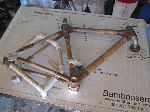 Abompe
is home to one of the bamboo bike frame building teams of the Bamboosero
project. The engineering for the bikes and the trainer of the teams is
U.S. master frame builder Craig Calfee. Craig has supplied the frame builders
with plans, jigs and manuals with exhaustive details for each kind and size of
bike they build. With a tape measure, bamboo and epoxy the team should be
able to build a bike. Abompe
is home to one of the bamboo bike frame building teams of the Bamboosero
project. The engineering for the bikes and the trainer of the teams is
U.S. master frame builder Craig Calfee. Craig has supplied the frame builders
with plans, jigs and manuals with exhaustive details for each kind and size of
bike they build. With a tape measure, bamboo and epoxy the team should be
able to build a bike.
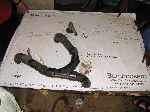
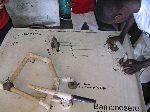
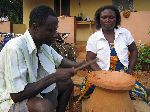 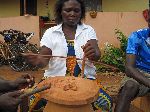 A
second, and much more traditional, output of the area is bauxite beads. The
aluminum oxide stone (bauxite) is mined from Bepoben mountain, behind the
village, and has been for at least a century. A
second, and much more traditional, output of the area is bauxite beads. The
aluminum oxide stone (bauxite) is mined from Bepoben mountain, behind the
village, and has been for at least a century.
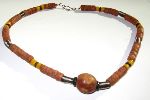 Historically
the making of bauxite beads was more wide spread, but now-a-days Abompe is the
only village carrying on the craft. The bead is made by chipping the stone
to the proper size and then using a bow-drill to punch a hole through it. The
beads are then polished. The final step is to string them into necklaces
and bracelets. If you are in Abompe you can purchase one directly from the
producer. Historically
the making of bauxite beads was more wide spread, but now-a-days Abompe is the
only village carrying on the craft. The bead is made by chipping the stone
to the proper size and then using a bow-drill to punch a hole through it. The
beads are then polished. The final step is to string them into necklaces
and bracelets. If you are in Abompe you can purchase one directly from the
producer.
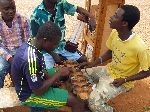 Perhaps it was the afternoon heat which prompted these gentlemen to take a
break from whatever they were doing to compete at the seed game. The
game, with slight variations, is played across sub-Saharan Africa.
The main difference from place to place is the name. In the Twi speaking
part of Ghana the game is called owari. Some of the other names is
West Africa are: wori (Malinke, Mali),
gbo walo (Bassa, Liberia), ma kpo (Mano, Liberia), tay gbo knongi (Gbandi,
Liberia), mana (Kpelle, Liberia),
wrah (Kru, Liberia), wosley (Ivory Coast), ajato (KoGbe, Benin), aju (Ewe,
Togo), ayo (Yoruba, Nigeria), bmang (Grassfields, Cameroon), and, mankala
(Disney). Perhaps it was the afternoon heat which prompted these gentlemen to take a
break from whatever they were doing to compete at the seed game. The
game, with slight variations, is played across sub-Saharan Africa.
The main difference from place to place is the name. In the Twi speaking
part of Ghana the game is called owari. Some of the other names is
West Africa are: wori (Malinke, Mali),
gbo walo (Bassa, Liberia), ma kpo (Mano, Liberia), tay gbo knongi (Gbandi,
Liberia), mana (Kpelle, Liberia),
wrah (Kru, Liberia), wosley (Ivory Coast), ajato (KoGbe, Benin), aju (Ewe,
Togo), ayo (Yoruba, Nigeria), bmang (Grassfields, Cameroon), and, mankala
(Disney).
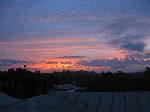 A few clouds in the sky are always good for enhancing the sunset.
A few clouds in the sky are always good for enhancing the sunset.
|
Addendum:
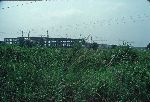
This building shells and construction crane sat
frozen in time just north of Legon for more than a decade. But here is proof
that time changes because the housing project
has now been finished
.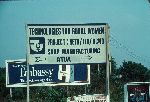
A sign for a rural women's soap manufacturing
project. Unfortunately limitations prevented us from getting down the road to visit or learn any thing more. |



















































